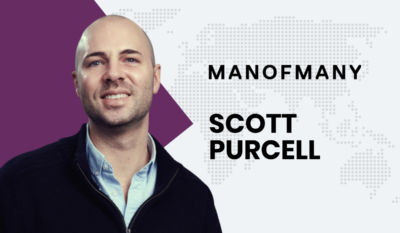In 2023, Media Collateral published a report: “Gen AI x Comms: Industry Impact Report.” For the 2024 edition, State of Digital Publishing (SODP) partnered up with Media Collateral to deliver insights to publishing, communications, and PR professionals, as well as journalists and content creators, on the impact of generative AI technologies on the industry.
As part of the research, Andrew Thompson (Research & Editorial Lead at Media Collateral) conducted a series of interviews with industry experts to help place the findings in a larger context and supplement the report with a qualitative analysis.
Scott Purcell is a member of the expert panel for the research study and below is his interview with Andrew Thompson.

Scott Purcell is a Co-founder of Man of Many and a CFA Charterholder. He is a renowned figure in the media industry. Before establishing Man of Many, Scott honed his skills over 7 years at Westpac Institutional Bank as a Senior Financial Analyst. His entrepreneurial spirit was recognized in 2017 when he was a Finalist for Young Entrepreneur at the NSW Business Chamber Awards.
With a special focus on lifestyle content, Scott has collaborated with leading international brands like Apple, Samsung, IWC, and TAG Heuer. Under his guidance, Man of Many triumphed as the Best Media Platform at the B&T Awards, 2023, and clinched the titles for Best Engagement Strategy, Website of the Year, and Publish Leader of the Year at the Mumbrella Publish Awards, 2023.
In 2024, Scott’s achievements were further recognised when he received MediaWeek’s Next of the Best Award for Publishing.
As a media industry leader, what are the major impacts you see Gen AI having for day-to-day communications practitioners?
I think Gen AI is revolutionising the media and communications landscape by automating a lot of administrative and routine tasks and providing faster and deeper insights through data analysis. For communications practitioners, we’ve used AI to automate some of our social media postings allowing our journalists to focus more on writing long-form content, strategy and creativity.
“We believe that accurate, realistic, and human-led reporting is critical to the ongoing success of the wider publishing industry and a vital resource in the fight against misinformation.“
However, it’s important to note that, as per our public AI Usage Policy, we’ve banned the use of Gen AI for written content published across our site. We believe that accurate, realistic, and human-led reporting is critical to the ongoing success of the wider publishing industry and a vital resource in the fight against misinformation.
Have you been surprised by the rapid advancement of Gen AI in the media and communications space over the past 12-18 months?
Quite frankly, no. I recently spoke at Unmade’s HumAIn conference and was incredibly surprised at how far behind many of the mainstream media and advertising industries were on this front. Yes, the rapid advancement of Gen AI has been quite remarkable. I do think the speed at which companies like Google are rolling it out has been rushed through (just look at the recent bungled roll-out of their AI Overviews), yet the traditional media and communications sectors seem to be very much behind the eight-ball at least from my observations. AI tools offer so much more beyond natural language processing or mass-produced automated content creation. The pace of development and the increasing accuracy and sophistication of these AI tools have the ability to not only save on costs in terms of greater efficiency but also to generate new revenue streams and opportunities for media as well, transforming how we approach various aspects of our work.
How have you used Gen AI in your and your team’s media and communications roles?
At Man of Many, we have integrated Gen AI across multiple facets of our operations. Our AI Suite includes tools such as the Advanced Sales Report for in-depth performance analysis. We also monitor advertiser spending across our competitors to identify and route opportunities to the relevant sales team members within their vertical. We built a Helpful Content Analysis Tool for editorial content optimisation. We also tested using an AI-powered chatbot to enhance user engagement and an Automated Social Tagging System for efficient content promotion. These tools have significantly improved our operational efficiency, allowing us to produce high-quality content at a faster rate and engage more effectively with our audience.
How is your usage evolving? Or how do you see it evolving?
Our usage of Gen AI is continually evolving as we explore new ways to leverage its capabilities. We are using AI vastly beyond drafting emails. One of its most powerful tools is knowledge management and the ability to quickly pull insights from our own knowledge base or research. Additionally, we leverage APIs to allow the models to move beyond simply generating text, using it for categorisation, tagging, generating alt-text, whilst interacting with many other tools as an AI Agent. This saves us time on many administrative tasks so we can focus on the important things at hand. We also plan to integrate AI more deeply into our advertising operations to optimise campaign performance and ROI.
What are your greatest hopes for how generative AI can benefit you as a media/communications professional, but also the industry as a whole?
“I hope that AI will actually mean readers start to properly value the worth of media and communications professionals.“
My greatest hope is that generative AI will continue to enhance efficiency, creativity, and personalisation in the media and communications industry. For professionals, AI can reduce the burden of routine tasks, allowing more time for strategic thinking and creative work. Industry-wide, AI has the potential to drive innovation, improve content quality, and increase engagement by providing insights into audience behaviour and preferences. Additionally, AI can democratise content creation, giving smaller publishers access to powerful tools that were previously only available to larger organisations.
Beyond this, I hope that AI will actually mean readers start to properly value the worth of media and communications professionals. For instance, our published AI Usage policy for Man of Many absolutely bans the use of AI for any written editorial published on our site, and there’s a key reason behind this. Beyond plagiarism and loss of individual authorship, AI or Large Language Models are simply not capable of generating NEW information as they are only based on an existing body of knowledge.
Content from our partners
So, when you hear of publishers pumping out vast amounts of AI written content (or what some refer to as slop), this not only increasingly hits a road block due to Google’s sophisticated crawling filters, its simply not the sorts of information users wish to read or that Google is looking to reward. This is why are focused on producing high-quality, original and unique content that adds to a knowledge base or what Google refers to as “information gain” and it’s something that humans and journalists are perfectly built for.
The ongoing need for new, high-quality trustworthy information, particularly in a time when AI companies are already running out of information to train their models, means that such new media and journalism continue to hold immense value, not only for readers but also for AI Companies. It’s why we’ve seen OpenAI sign partnership agreements with the likes of News Corp, Axel Springer and Financial Times, underscoring the ongoing importance of media and the need for new high quality information and original reporting.
How can everyday media and communications professionals leverage the opportunities to advance in their roles?
Everyday media and communications professionals can leverage AI by experimenting with and embracing it as a tool for enhancing their productivity and creativity. One important step in this process is for management to allow staff the flexibility to experiment with proper guardrails, guidelines, and rules. It is also important to stay informed about the latest AI developments and continually seek out training and education opportunities. By integrating AI into their workflows, professionals can improve their efficiency, produce higher-quality work, and deliver more targeted and effective communications. I can’t tell you the number of new ideas we’ve come up with to save our team immense time with custom GPT’s fit for a specific purpose.
“By integrating AI into their workflows, professionals can improve their efficiency, produce higher-quality work, and deliver more targeted and effective communications.“
What are some of the major risks you see with Gen AI across the media and communications landscape? From job losses to ethical issues, to authorship, and misinformation?
The major risks associated with Gen AI definitely include job displacement, ethical concerns, and the potential for misinformation. It’s also important to note however that ATMs did not replace bank tellers. Humans, particularly in journalism, as still very much necessary. AIs can not fully conduct real-world research aside from what’s on the web. Ethical issues also arise around data privacy, bias in AI algorithms, and the transparency of AI-generated content. Authorship is another concern, as it becomes challenging to distinguish between human and AI-generated work, potentially undermining the value of human creativity. Misinformation is a significant risk, as AI tools can be used to generate and spread false information quickly and on a large scale.
What is your advice for everyday media practitioners seeking to navigate the risks?
“Embrace AI as a complement to human creativity rather than a replacement.“
To navigate these risks, media practitioners should focus on continuous learning and adapting to new technologies. Embrace AI as a complement to human creativity rather than a replacement. Stay informed about ethical AI practices and advocate for transparency and accountability in AI usage. Develop skills that AI cannot replicate, such as critical thinking, creativity, and emotional intelligence. Additionally, practitioners should engage with industry discussions on AI ethics and contribute to shaping policies that ensure responsible AI use. By staying proactive and informed, media professionals can harness AI’s benefits while mitigating its risks.
How do you see Gen AI impacting the way media and communications practitioners work in the next 5 years? Any predictions or future trends you would like to share?
In the next five years, Gen AI will become even more integrated into the daily workflows of media and communications practitioners, as it will all industries. We will see more advanced AI tools for personalised content creation, predictive analytics, and real-time audience engagement. AI will enable more immersive and interactive media experiences, such as virtual reality and augmented reality content. Ethical considerations will become increasingly important, and there will be a greater emphasis on developing and adhering to standards for responsible AI use. Overall, AI will drive significant innovation and efficiency in the industry, transforming how we create, distribute, and consume media if we’re willing to use the tools properly.












